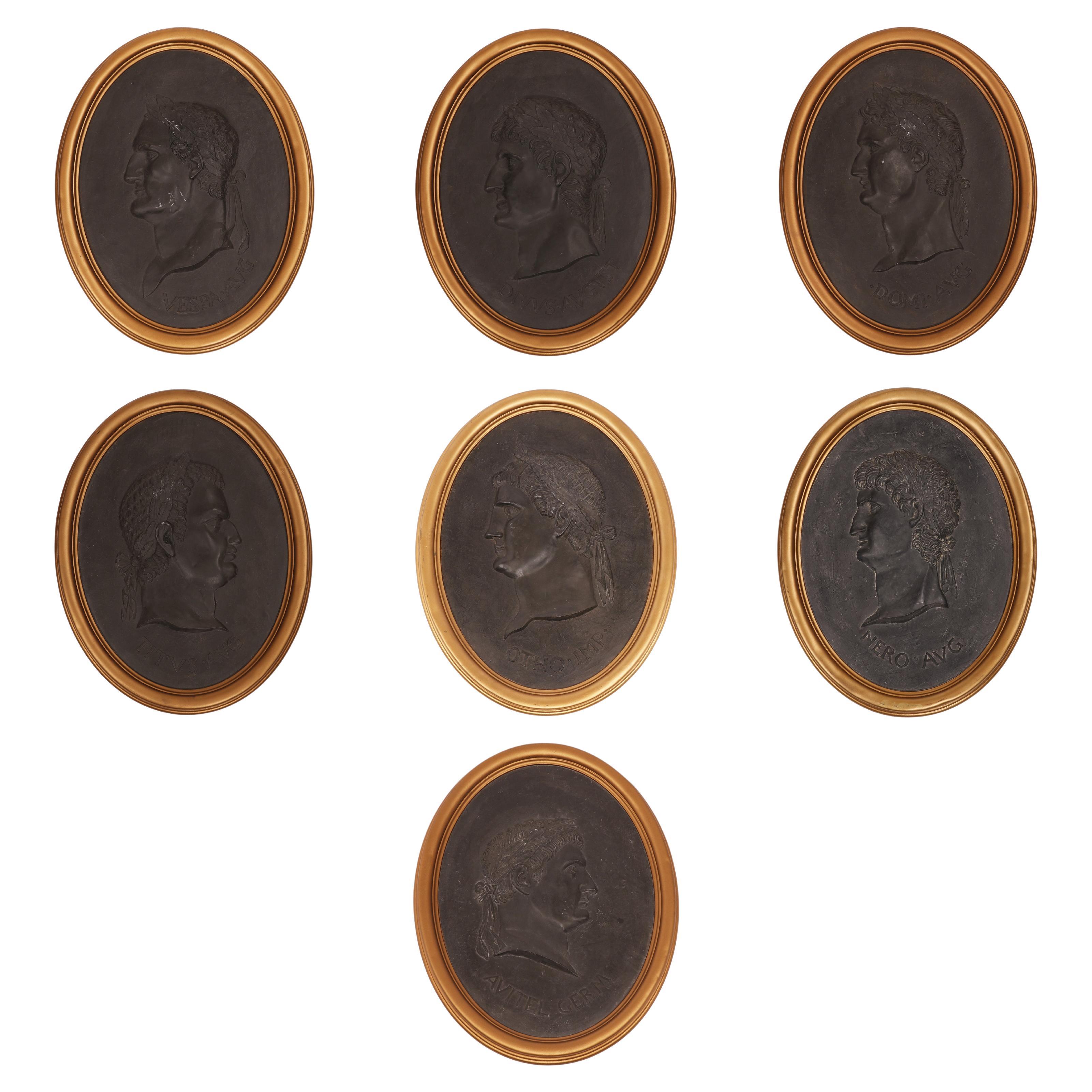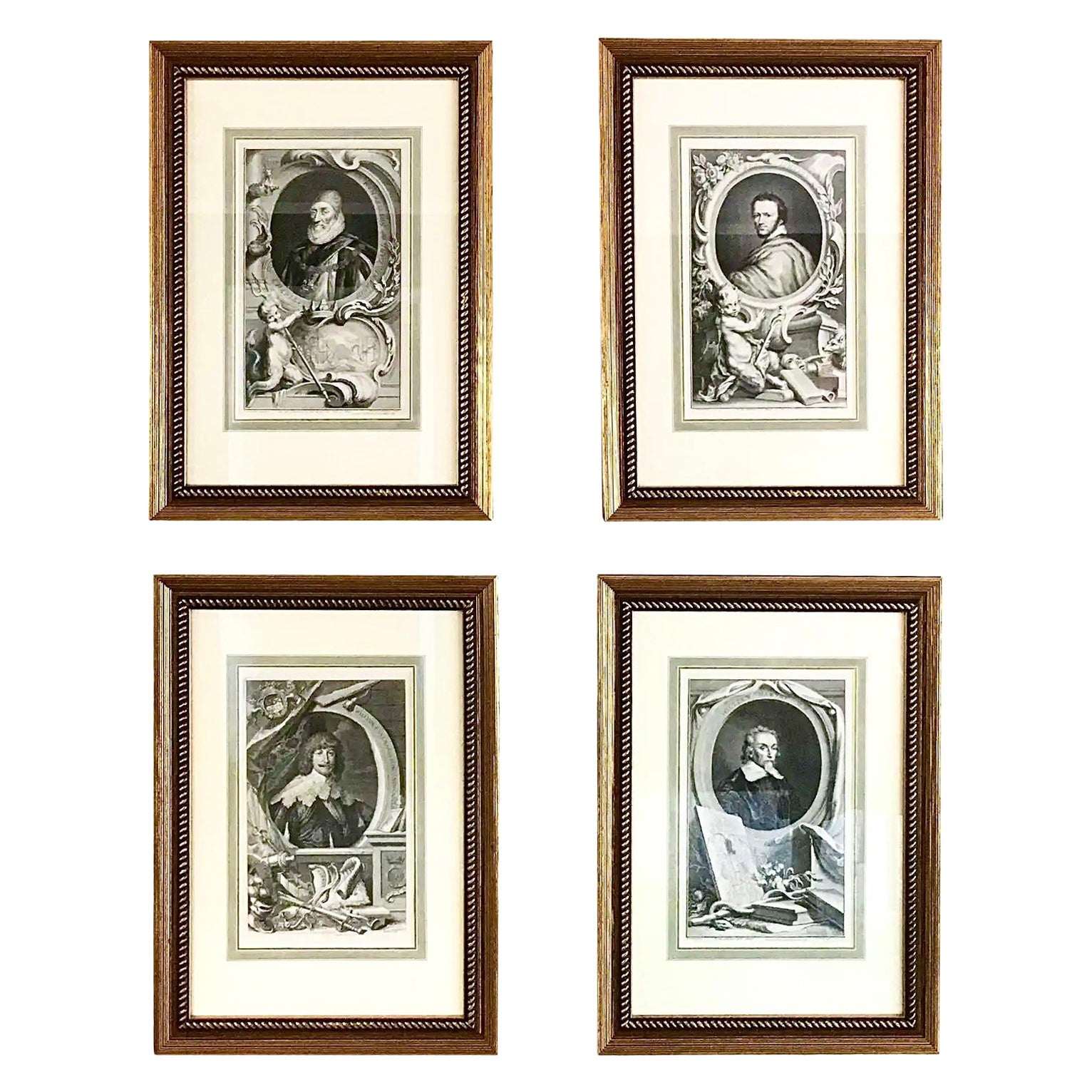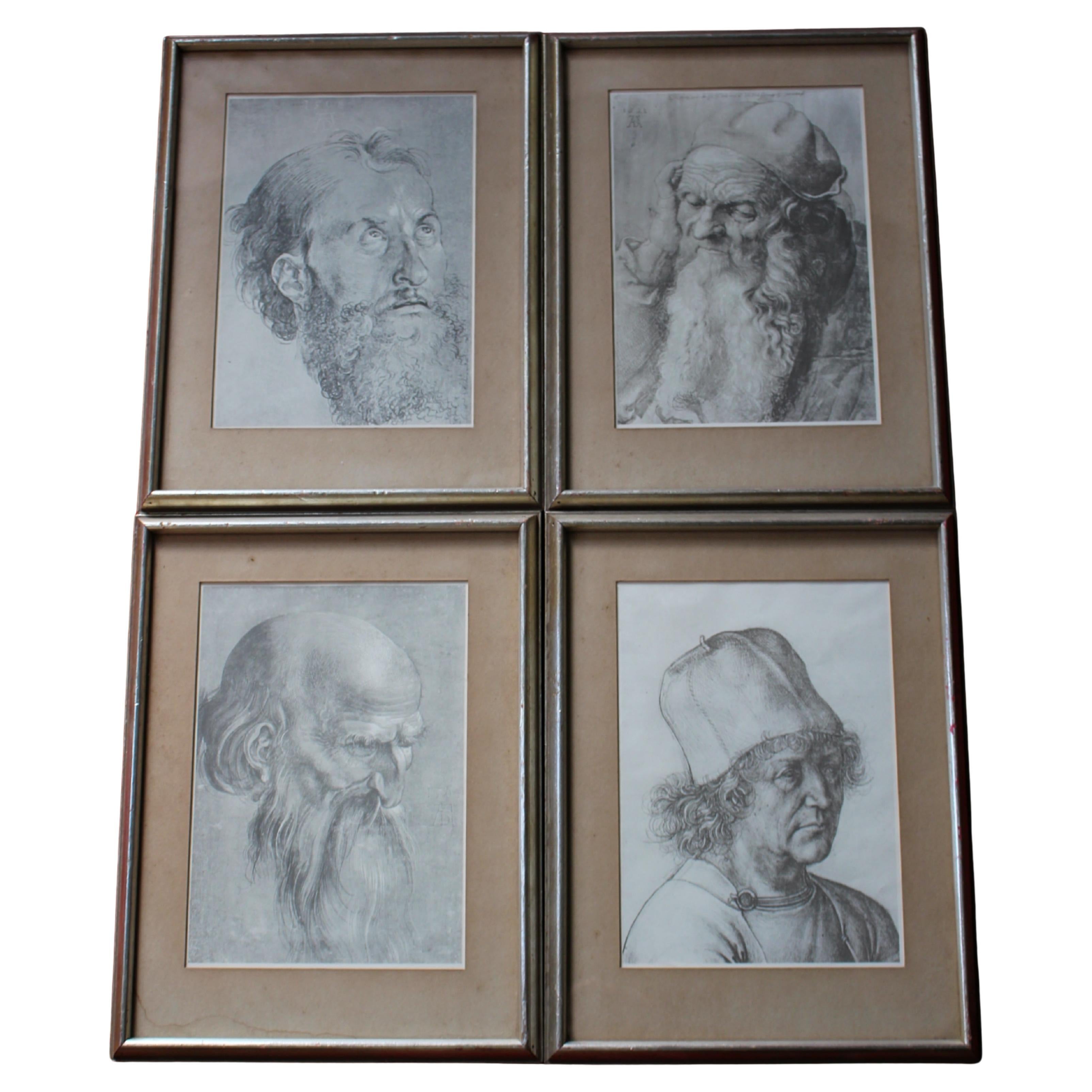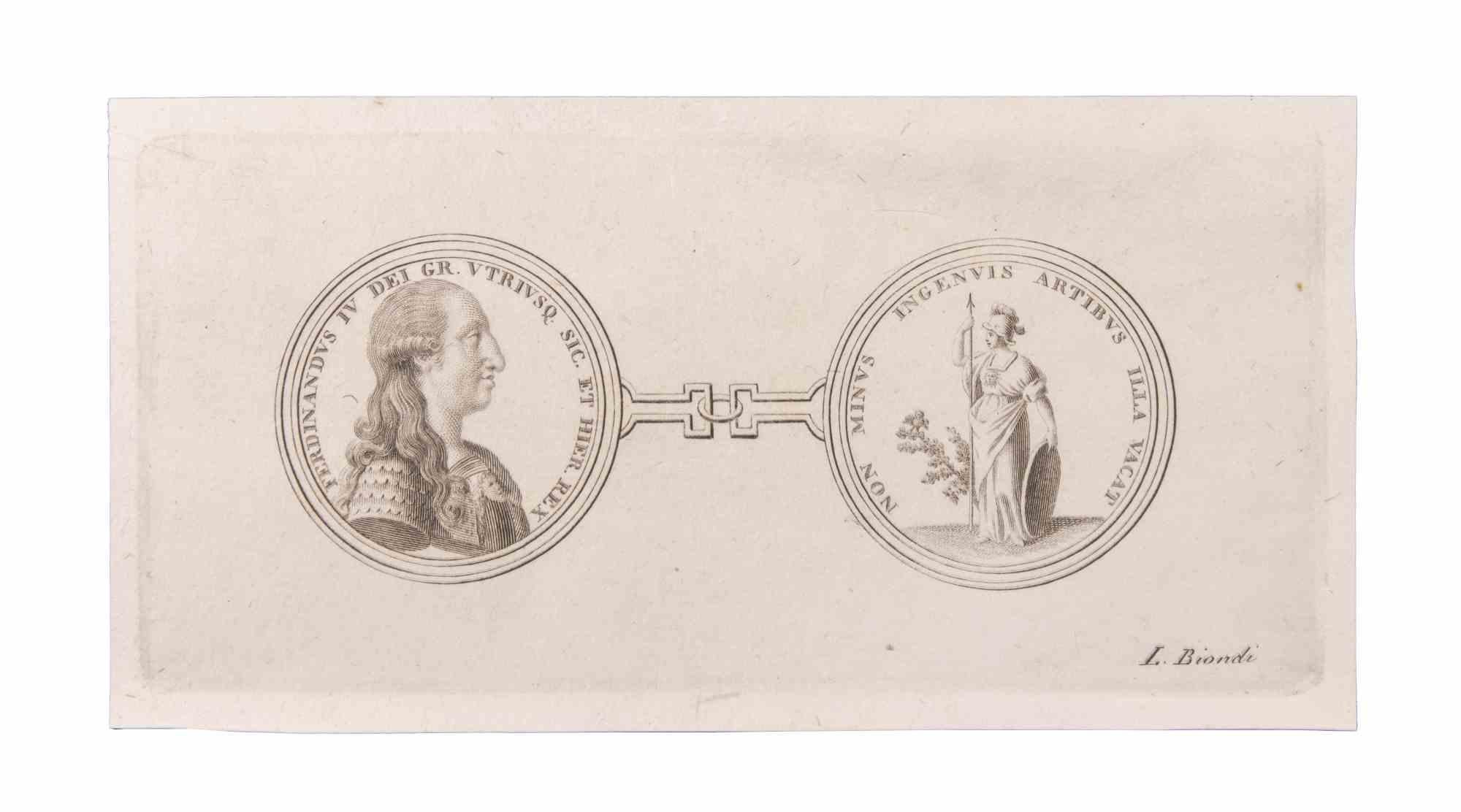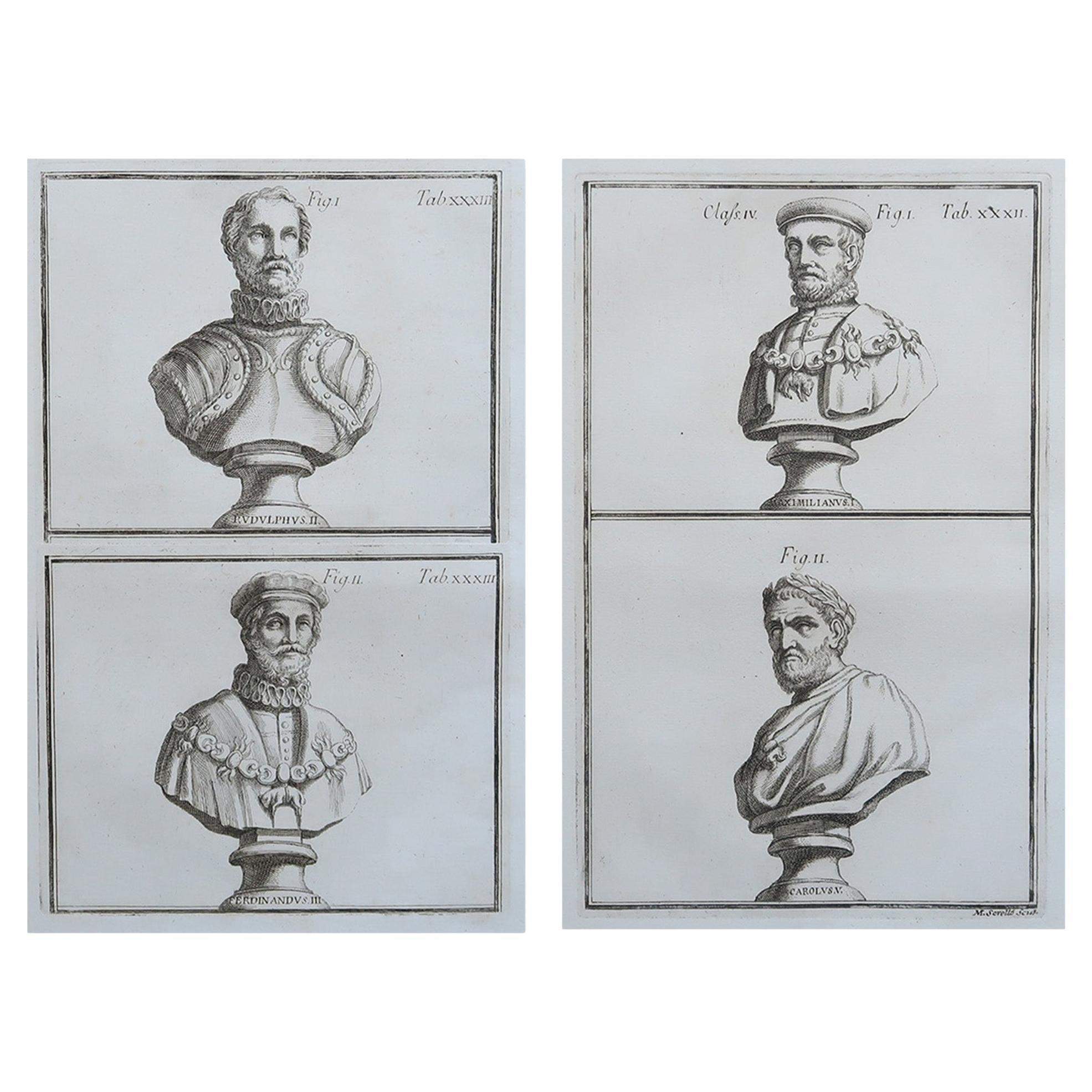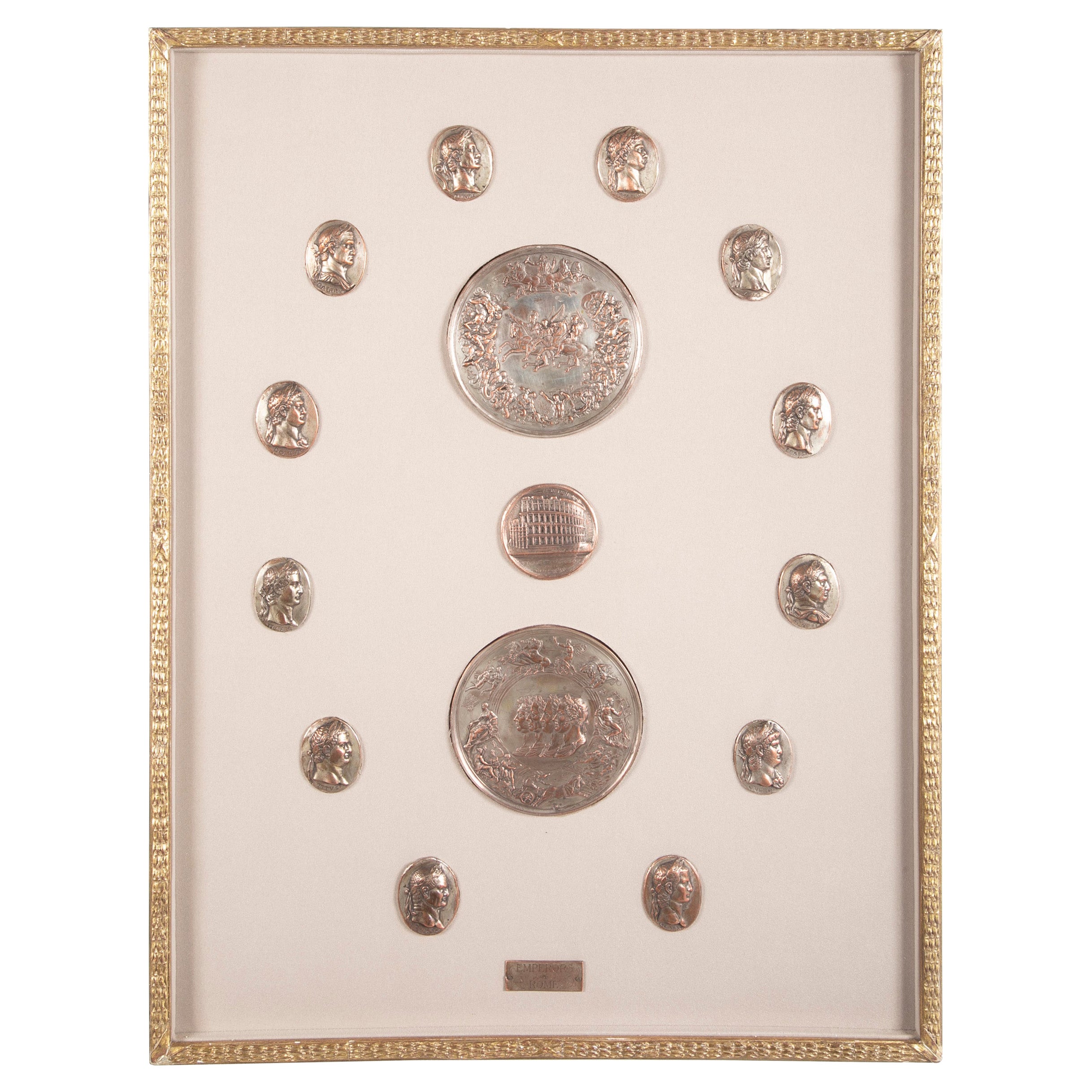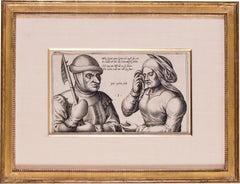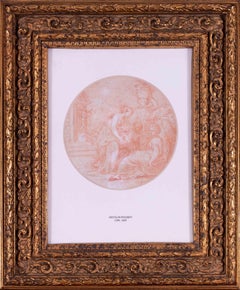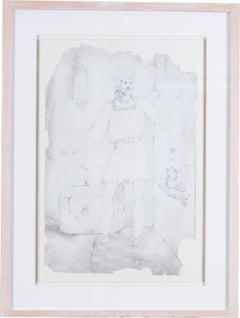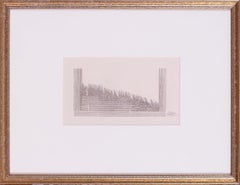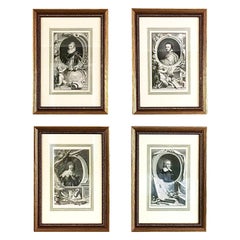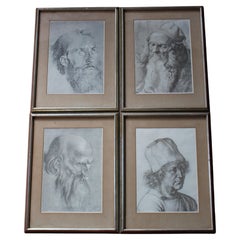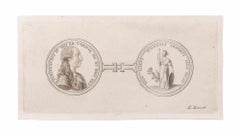Items Similar to Four chiaroscuro medallion portrait woodcuts of emperors in sepia tones c.1557
Want more images or videos?
Request additional images or videos from the seller
1 of 13
Four chiaroscuro medallion portrait woodcuts of emperors in sepia tones c.1557
$2,194.83
£1,600
€1,874.42
CA$3,082.75
A$3,393.87
CHF 1,734.62
MX$40,506.81
NOK 22,085.38
SEK 20,666.99
DKK 14,000.80
About the Item
After Hubert Goltzius (Dutch, 1526-1583)
Maximilian; Frideri; Hadrian; and Antoninus
Four chiaroscuro medallion portrait woodcuts of emperors in sepia tones c.1557,
the diameter of each print 18.5cm overall frame dimension approximately 54 x 54cm
Provenance: Trowbridge Gallery
- Dimensions:Height: 21.25 in (53.98 cm)Width: 21.25 in (53.98 cm)Depth: 1 in (2.54 cm)
- Medium:
- Movement & Style:
- After:Hubert Goltzius (1526 - 1583, Dutch)
- Period:
- Condition:in overall good order, some oxidisation, behind glass which would benefit a wipe on the inside, in matching white mounts with gilt striplines, cream frames with black outer edges, several abrasions which we may retouch to black areas.
- Gallery Location:Petworth, GB
- Reference Number:1stDibs: LU540311542412
About the Seller
4.9
Platinum Seller
Premium sellers with a 4.7+ rating and 24-hour response times
Established in 2010
1stDibs seller since 2017
273 sales on 1stDibs
Typical response time: 2 hours
- ShippingRetrieving quote...Shipping from: Petworth, United Kingdom
- Return Policy
Authenticity Guarantee
In the unlikely event there’s an issue with an item’s authenticity, contact us within 1 year for a full refund. DetailsMoney-Back Guarantee
If your item is not as described, is damaged in transit, or does not arrive, contact us within 7 days for a full refund. Details24-Hour Cancellation
You have a 24-hour grace period in which to reconsider your purchase, with no questions asked.Vetted Professional Sellers
Our world-class sellers must adhere to strict standards for service and quality, maintaining the integrity of our listings.Price-Match Guarantee
If you find that a seller listed the same item for a lower price elsewhere, we’ll match it.Trusted Global Delivery
Our best-in-class carrier network provides specialized shipping options worldwide, including custom delivery.More From This Seller
View All17th Century Dutch engraving 'Mein Greit; Mein Greit'
Located in Petworth, West Sussex
Julius Goltzius (Dutch c.1550-1595)
Mein Greit; Mein Greit
Engraving
6.5/8 x 11.3/8 in. (16.8 x 29 cm.) (measured to slip edge)
Christie’s have suggested this impression is from the ...
Category
17th Century Old Masters Figurative Prints
Materials
Engraving
17th Century French sanguine drawing of maiden's harvesting flowers
By (Circle of) Nicolas Poussin
Located in Petworth, West Sussex
Circle of Nicolas Poussin (French, 1594-1665)
Maiden’s harvesting flowers
Sanguine on paper
8. ¾ in. (22 cm.) tondo
Category
17th Century Old Masters Figurative Drawings and Watercolors
Materials
Paper
Pre-Raphaelite, early 19th Century drawing by the British artist Lord Leighton
By Frederic Leighton
Located in Petworth, West Sussex
Lord Frederick Leighton (British, 1830-1896)
A Medieval Allegory
Not signed
pencil on paper
the fragment measures approx. 19.1/2 x 13 in.
(49.5 x 33 cm.)
Provenance: Gifted by Leighton to his cousin Edith Emily Jellicorse, nee Garnham, and thence by descent.
We would like to thank Daniel Robins, the curator at Leighton House for the authenticating this work in full.
Daniel has suggested this study would have been executed when Leighton was studying in Frankfurt
Leighton was born in Scarborough to Augusta Susan and Dr. Frederic Septimus Leighton. He received his artistic training on the European continent, first from Eduard von Steinle and then from Giovanni Costa. According to Daniel Robbins, the curator at Leighton House, This drawing comes from the time Leighton studied under Eduard von Steinle. He then studied at the Accademia di Belle Arti in Florence. From 1855 to 1859 he lived in Paris, where he met Ingres, Delacroix, Corot and Millet. In 1860, he moved to London, where he associated with the Pre-Raphaelites. In 1864 he became an associate of the Royal Academy and in 1878 he became its President (1878–96). American art critic Earl Shinn claimed at the time that "Except Leighton, there is scarce any one capable of putting up a correct frescoed figure in the archway of the Kensington Museum." His paintings represented Britain at the great 1900 Paris Exhibition. Leighton was knighted at Windsor in 1878 and was created a baronet, of Holland Park Road eight years later. He was the first painter to be given a peerage. Leighton remained a bachelor and rumours of him having an illegitimate child with one of his models, in addition to the supposition that Leighton may have been a homosexual, continue to be debated. On his death his barony was extinguished after existing for only a day; this is a record in the Peerage. His house in Holland Park, London has been turned into a museum. It contains many of his drawings and paintings, as well as some of his former art collection including a painting dedicated to Leighton by Sir John Everett Millais. The house also features many of Leighton's inspirations, including his collection of Iznik tiles. Its centrepiece is the magnificent Arab Hall. Leighton was an enthusiastic volunteer soldier, enrolling with the first group to join the 38th Middlesex (Artists') Rifle Volunteer Corps (later to be known as the Artists Rifles...
Category
19th Century Pre-Raphaelite Figurative Drawings and Watercolors
Materials
Paper, Pencil
Signed art deco woodcut, by Edward Gordon Craig 'Army of Fortinbras'
Located in Petworth, West Sussex
Edward Gordon Craig (British, 1872 – 1966)
Army of Fortinbras
Woodcut
Signed with monogram (lower right)
4.3/4 x 8.1/4 in. (12 x 20.8cm.)
A beauti...
Category
20th Century Art Deco Figurative Prints
Materials
Woodcut
Lord Frederick Leighton drawing, British pre-Raphaelite, original
By Frederic Leighton
Located in Petworth, West Sussex
Lord Frederick Leighton (British, 1830-1896)
Apprehending a thief
pencil on paper
the fragment measures approx. 17.1/3 x 11in. (44 x 28cm.)
signed ‘F Leighton’ (lower right)
Provenance: Gifted by Leighton to his cousin Edith Emily Jellicorse, nee Garnham, and thence by descent
We would like to thank Daniel Robins, the curator at Leighton House for the authenticating this work in full.
Daniel has suggested this study would have been executed when Leighton was studying in Frankfurt
Leighton was born in Scarborough to Augusta Susan and Dr. Frederic Septimus Leighton. He received his artistic training on the European continent, first from Eduard von Steinle and then from Giovanni Costa. According to Daniel Robbins, the curator at Leighton House, This drawing comes from the time Leighton studied under Eduard von Steinle. He then studied at the Accademia di Belle Arti in Florence. From 1855 to 1859 he lived in Paris, where he met Ingres, Delacroix, Corot and Millet. In 1860, he moved to London, where he associated with the Pre-Raphaelites. In 1864 he became an associate of the Royal Academy and in 1878 he became its President (1878–96). American art critic Earl Shinn claimed at the time that "Except Leighton, there is scarce any one capable of putting up a correct frescoed figure in the archway of the Kensington Museum." His paintings represented Britain at the great 1900 Paris Exhibition. Leighton was knighted at Windsor in 1878 and was created a baronet, of Holland Park Road eight years later. He was the first painter to be given a peerage. Leighton remained a bachelor and rumours of him having an illegitimate child with one of his models, in addition to the supposition that Leighton may have been a homosexual, continue to be debated. On his death his barony was extinguished after existing for only a day; this is a record in the Peerage. His house in Holland Park, London has been turned into a museum. It contains many of his drawings and paintings, as well as some of his former art collection including a painting dedicated to Leighton by Sir John Everett Millais. The house also features many of Leighton's inspirations, including his collection of Iznik tiles. Its centrepiece is the magnificent Arab Hall. Leighton was an enthusiastic volunteer soldier, enrolling with the first group to join the 38th Middlesex (Artists') Rifle Volunteer Corps (later to be known as the Artists Rifles...
Category
19th Century Pre-Raphaelite Figurative Drawings and Watercolors
Materials
Paper, Pencil
Set of 4 art nouveau lithographs by Scottish female artist Hannah Frank
Located in Petworth, West Sussex
A very nice set of four art nouveau lithographs by the Scottish female artist Hannah Frank.
Hannah Frank was born in Glasgow to Jewish Russian immigran...
Category
20th Century Art Nouveau Figurative Prints
Materials
Lithograph
You May Also Like
Gold Frame Portrait Medallions of the Seven Caesars
Located in New York, NY
These oval medallions, sold individually, feature profile portraits of seven Roman Caesars rendered in low relief against a textured background. Each medallion is inscribed with the ...
Category
Vintage 1980s Unknown Classical Roman Decorative Art
Materials
Resin
Framed 18th Century Neoclassical Style Portrait Engravings, Set of 4
Located in Elkhart, IN
A lovely set of four 18th century style portrait engravings with allegorical scenes presented in giltwood frames under glass with very fine hand-colored matting. The engravings were ...
Category
Late 20th Century American Neoclassical Prints
Materials
Glass, Giltwood, Paper
Early 20th Collection of Four Silver Gilt Framed Da Vinci Portrait Prints
Located in Lowestoft, GB
Collection of four 20th century silver gilt wood framed and glazed Da Vinci portraits, circa 1920.
Age related discolouration and some minor staining to the mounts.
frames 2cm in d...
Category
Early 20th Century European Prints
Materials
Glass, Giltwood, Paper
Medallions - Etching by Luigi Biondi - 18th Century
Located in Roma, IT
Medallions is an Etching realized by Luigi Biondi (1776-1839).
The etching belongs to the print suite “Antiquities of Herculaneum Exposed” (original title: “Le Antichità di Ercolan...
Category
Late 18th Century Old Masters Figurative Prints
Materials
Etching
Large Scale Original Antique Prints of Renaissance Busts. Rome 1776
Located in St Annes, Lancashire
Wonderful images of renaissance busts
Copper-plate engravings
Published by Monaldini, Rome, 1776
Good quality wove paper
Free shipping
Category
Antique 1770s Italian Renaissance Prints
Materials
Plaster
19th Century Italian Grand Tour Set of Portrait Medals of The 12 Roman Emperors
Located in Stamford, CT
19th century Italian Grand Tour set of silvered bronze portrait medallions of The 12 Roman Emperors, Julius Caesar, Augustus, Tiberius, Caligula, Claudius
Nero, Galba, Otho, Vitelliu...
Category
Antique Early 19th Century Italian Grand Tour Decorative Art
Materials
Bronze
More Ways To Browse
Antique Sepia
Portrait Medallion
Portrait Of Emperor
Antique Sepia Prints
Chiaroscuro Woodcut
Scorpio Art
Signed Chagall Print
Signed Prints By Dali
Simbari Lithograph
Star Legend
Sumo Print
Used Pacemaker
William Temple
Alexej Von Jawlensky
Alice In Wonderland Prints Vintage
Barbizon Etchings
Chagall Flowers
Chagall Galerie Maeght
